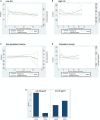SARS-CoV-2 Viremia Precedes an IL6 Response in Severe COVID-19 Patients: Results of a Longitudinal Prospective Cohort
- PMID: 35783606
- PMCID: PMC9240748
- DOI: 10.3389/fmed.2022.855639
SARS-CoV-2 Viremia Precedes an IL6 Response in Severe COVID-19 Patients: Results of a Longitudinal Prospective Cohort
Abstract
Background: Interleukin 6 (IL6) levels and SARS-CoV-2 viremia have been correlated with COVID-19 severity. The association over time between them has not been assessed in a prospective cohort. Our aim was to evaluate the relationship between SARS-CoV-2 viremia and time evolution of IL6 levels in a COVID-19 prospective cohort.
Methods: Secondary analysis from a prospective cohort including COVID-19 hospitalized patients from Hospital Universitario La Princesa between November 2020 and January 2021. Serial plasma samples were collected from admission until discharge. Viral load was quantified by Real-Time Polymerase Chain Reaction and IL6 levels with an enzyme immunoassay. To represent the evolution over time of both variables we used the graphic command twoway of Stata.
Results: A total of 57 patients were recruited, with median age of 63 years (IQR [53-81]), 61.4% male and 68.4% Caucasian. The peak of viremia appeared shortly after symptom onset in patients with persistent viremia (more than 1 sample with > 1.3 log10 copies/ml) and also in those with at least one IL6 > 30 pg/ml, followed by a progressive increase in IL6 around 10 days later. Persistent viremia in the first week of hospitalization was associated with higher levels of IL6. Both IL6 and SARS-CoV-2 viral load were higher in males, with a quicker increase with age.
Conclusion: In those patients with worse outcomes, an early peak of SARS-CoV-2 viral load precedes an increase in IL6 levels. Monitoring SARS-CoV-2 viral load during the first week after symptom onset may be helpful to predict disease severity in COVID-19 patients.
Keywords: COVID-19; SARS-CoV-2; interleukin 6 (IL-6); prognosis; viremia.
Copyright © 2022 Roy-Vallejo, Cardeñoso, Triguero-Martínez, Chicot Llano, Zurita, Ávalos, Barrios, Hernando, Ortiz, Rodríguez-García, Ciudad Sañudo, Marcos, García Castillo, Fontán García-Rodrigo, González, Méndez, Iturrate, Sanz-García, Villa, Sánchez-Azofra, Quicios, Arribas, Álvarez Rodríguez, Patiño, Trigueros, Uriarte, Martín-Ramírez, Arévalo Román, Galván-Román, García-Vicuña, Ancochea, Muñoz-Calleja, Fernández-Ruiz, de la Cámara, Suárez Fernández, González-Álvaro, Rodríguez-Serrano and the PREDINMUN-COVID Group.
Conflict of interest statement
The authors declare that the research was conducted in the absence of any commercial or financial relationships that could be construed as a potential conflict of interest.
Figures



References
LinkOut - more resources
Full Text Sources
Miscellaneous

